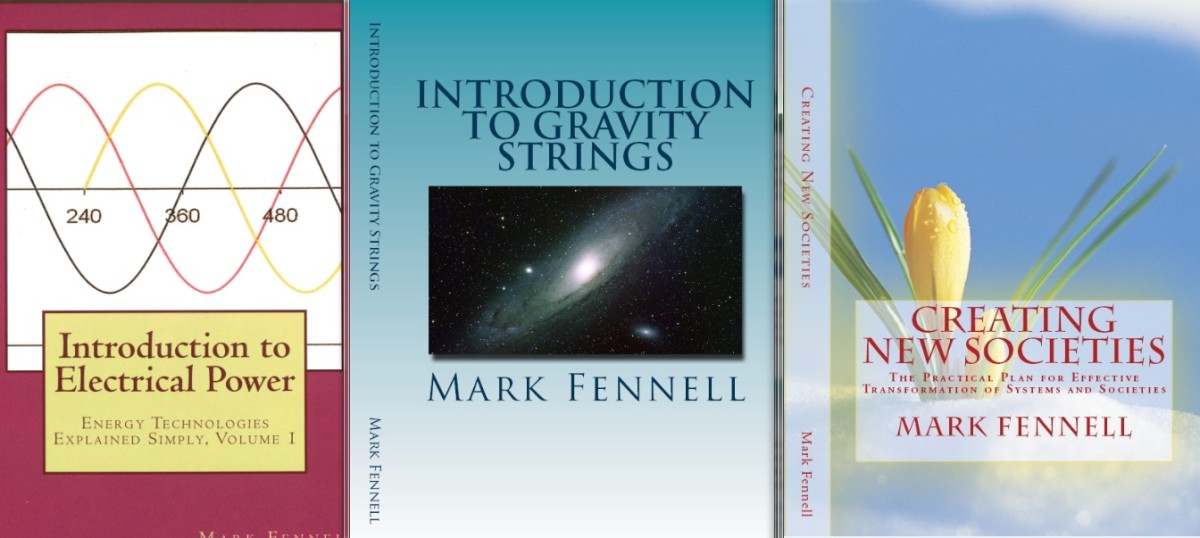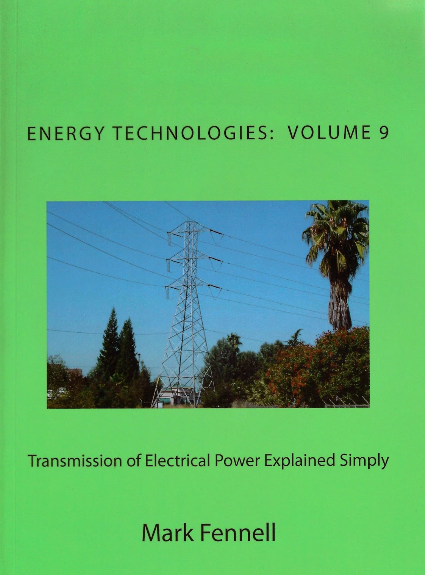Transmission of Electrical Power Explained Simply
Overview
This book discusses everything you need to know regarding the transmission and distribution of electrical power. In this book you will learn the sequence of events and the technologies available for sending electrical power from the power plants to the appliances.
This book is also a “field guide” (with numerous pictures) designed to help you identify components of the transmission system which you may see every day around you.
Chapters Include
- Sequence from Power Plant to Home
- Transformers and Substations
- Power Lines Overview
- High Voltage Transmission Lines
- Community Level Distribution Lines
- High Voltage Direct Current (HVDC) Power Lines
- Underground Electrical Cables
- Cable Design and Laying Cable
- To the Homes and Businesses
- Appendix and Index
Expanded Table of Contents for Transmission of Electrical Power
Importance of This Book
Understanding the Options are Important for Efficiency
Note that these transmission technologies are important yet not discussed enough. We can save more power through effective transmission technologies than we can through simply “turning off the lights”. Did you know that in some regions of the world the transmission system is so inefficient that most of the power is lost before reaching the customer? Even in the US we lose significant power through improperly chosen transmission technologies. Therefore it is essential that policy makers understand the options.
Importance of a Well-Designed Transmission System
Improperly designed transmission systems can lose significant amounts of power. There are regions of the world with transmission systems so poorly designed that most of the power is lost before reaching the home or business.
Furthermore, the amount of power lost, even for otherwise well designed systems, is directly related to the distance of the power line. While well-meaning decision makers are building longer and longer power lines, we are losing more and more of the power we generated, before the end user sees any of it.
On the other hand, creating the right transmission system can reduce our power loss, which is another way of conserving energy. Therefore, rather than only using a “turn off the lights” approach to saving energy, we can save energy on a much grander scale simply through developing properly designed power transmission systems.
Factors to Consider, Factors to Discuss
There are many factors to consider when creating a transmission system for electrical power. The first level of factors includes placement of power lines, type of transformers, and use of substations. We then must select the material and size for our wires.
We must also consider whether to place lines above ground or below ground, and how to protect the power lines against damage from weather and geology.
As we reach the end user there are other factors to consider, such as what voltage to use, how many phases of power, and many other options related to circuitry.
Therefore this book discusses many factors, all of which will guide the reader to properly designing the best electrical power transmission and distribution system for any situation.
Features of this Book
There are two main aspects of this book the reader will appreciate. The first is that this book is a “Field Guide” to systems of power lines and wires which surround us everyday. The second is that this book offers numerous practical tips for anyone who is directly involved with planning or instillation of these electrical wiring systems.
As a Field Guide, this book will show you the process of electrical power delivery, from power plant to your home, and through the interior of your home. There are numerous pictures of the devices and structures so that you will be able to recognize and identify every item related to electrical power delivery in your world.
As a Practical Guide, this book offers numerous practical tips regarding the planning and instillation of electrical delivery technologies. There are numerous choices to be made, such as wire size, voltage to be used, above ground or below ground, and placement of structures. This book will guide you in making those choices.
There are also numerous practical tips, for areas such as: cable design, how to bury cable effectively, right of way issues, protection from weather, and other practical concerns. These tips are supplemented with data tables.
As always, this book is written simply and clearly. It will be useful for the curious reader, as well as quick summary for decision-makers, and a practical introduction for those who plan on working in the field.
Research for Transmission of Electrical Power Publications
Details Worth Noting in This Book (Chapter by Chapter)
The first chapter provides an overview of the electrical power transmission system. You will get a broad perspective. Here you will learn the main components and the sequence of the process.
Chapter two discusses transformers and substations. In this chapter you will learn how a transformer works, the terminology associated with a transformer, and how to calculate voltage change through any transformer. You will also be able to identify the main transformer types and arrangements. The chapter concludes with an overview of substations, focusing on the main possible uses of substations.
Chapter three provides an overview of power lines. Two of the most critical decisions when creating the best transmission system are selecting the right power line and placing the power line in the best location. Therefore this chapter provides an overview of the factors to consider when selecting and placing power lines. Note that most of the rest of the book discusses those factors in detail.
Chapter four discusses high voltage transmission lines. In this chapter you will learn the types of high voltage lines. You will be able to identify possible arrangements of high voltage lines on transmission towers. You will learn the best choices for materials for the power lines. A separate section is devoted to weather tips: how to ensure that power lines survive the most extreme weather. The chapter ends with a detailed discussion of safety of high voltage lines, including the effects of EMF on human health.
Chapter five discusses the lower level voltage lines which are used in neighborhoods. In this chapter you will learn about the design and maintenance options for the power lines near your home.
Chapter six is devoted to the new technology of high voltage direct current (HVDC) power lines. Used properly these lines are beneficial, yet used improperly these power lines will waste enormous amounts of power. In this chapter you will learn the advantages, disadvantages, and best uses of HVDC power lines.
Chapters seven and eight discuss underground cables for power lines. Underground cables allow the region to look neater, yet there are many difficulties associated with underground cables. The primary concerns are the effects of geology and water on the power lines. Other issues include limited access for maintenance, increased cost, and interference with other underground structures.
Therefore in chapter seven you will learn the advantages and disadvantages for underground placement of power cables.
In chapter eight you will learn some of the most important practical tips for installing underground cables (primarily to protect against geological effects).
The final chapter discusses the sequence of power through the homes and businesses. The topics in this chapter relate to the components and events in your home. Here you will learn exactly how the electrical power flows from the transformer outside your home, through your home into the appliance, and outward again. You will also learn some basic home electrical concepts, such as prongs and outlets, variation in voltages, and colors of wires.
In this chapter you will also learn how businesses use electrical power for their needs. You will learn the design options which should be considered when creating an electrical distribution system for large facilities.
At the end of the book you will find an Appendix with two data tables: 1) wire sizes in different units, and 2) resistance in wires based on type of material and wire size.
In total, everything in this book will help you design the best power transmission system for your region and needs. This book will also be your field guide, helping you understand the components of electrical power distribution that you see around you every day.
E-books on Transmission of Electrical Power
Videos related to Transmission of Electrical Power

